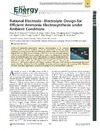Please use this identifier to cite or link to this item:
https://accedacris.ulpgc.es/jspui/handle/10553/74925
| DC Field | Value | Language |
|---|---|---|
| dc.contributor.author | Suryanto, Bryan H. R. | en_US |
| dc.contributor.author | Kang, Colin S. M. | en_US |
| dc.contributor.author | Wang, Dabin | en_US |
| dc.contributor.author | Xiao, Changlong | en_US |
| dc.contributor.author | Zhou, Fengling | en_US |
| dc.contributor.author | Azofra Mesa, Luis Miguel | en_US |
| dc.contributor.author | Cavallo, Luigi | en_US |
| dc.contributor.author | Zhang, Xinyi | en_US |
| dc.contributor.author | MacFarlane, Douglas R. | en_US |
| dc.date.accessioned | 2020-10-21T10:55:06Z | - |
| dc.date.available | 2020-10-21T10:55:06Z | - |
| dc.date.issued | 2018 | en_US |
| dc.identifier.issn | 2380-8195 | en_US |
| dc.identifier.uri | https://accedacris.ulpgc.es/handle/10553/74925 | - |
| dc.description.abstract | Renewable energy-driven ammonia electrosynthesis by N2 reduction reaction (NRR) at ambient conditions is vital for sustainability of both the global population and energy demand. However, NRR under ambient conditions to date has been plagued with a low yield rate and selectivity (<10%) due to the more favorable hydrogen evolution reaction (HER) in aqueous media. Herein, surface area enhanced α-Fe nanorods grown on carbon fiber paper were used as NRR cathodes in an aprotic fluorinated solvent–ionic liquid mixture. Through this design, significantly enhanced NRR activity with an NH3 yield rate of ∼2.35 × 10–11 mol s–1 cmGSA–2, (3.71 × 10–13 mol s–1 cmECSA–2) and selectivity of ∼32% has been achieved under ambient conditions. This study reveals that the use of hydrophobic fluorinated aprotic electrolyte effectively limits the availability of protons and thus suppresses the competing HER. Therefore, electrode–electrolyte engineering is essential in advancing the NH3 electrosynthesis technology. | en_US |
| dc.language | eng | en_US |
| dc.relation.ispartof | ACS Energy Letters | en_US |
| dc.source | ACS Energy Letters [ISSN 2380-8195], v. 3, 6, p. 1219–1224 | en_US |
| dc.subject | 2210 Química física | en_US |
| dc.title | Rational Electrode–Electrolyte Design for Efficient Ammonia Electrosynthesis under Ambient Conditions | en_US |
| dc.type | info:eu-repo/semantics/article | en_US |
| dc.type | Article | en_US |
| dc.identifier.doi | 10.1021/acsenergylett.8b00487 | en_US |
| dc.description.lastpage | 1224 | en_US |
| dc.identifier.issue | 6 | - |
| dc.description.firstpage | 1219 | en_US |
| dc.relation.volume | 3 | en_US |
| dc.investigacion | Ciencias | en_US |
| dc.type2 | Artículo | en_US |
| dc.description.observaciones | NO ULPGC | en_US |
| dc.description.numberofpages | 6 | en_US |
| dc.utils.revision | Sí | en_US |
| dc.identifier.ulpgc | No | en_US |
| dc.description.sjr | 6,734 | |
| dc.description.jcr | 16,331 | |
| dc.description.sjrq | Q1 | |
| dc.description.jcrq | Q1 | |
| dc.description.scie | SCIE | |
| item.grantfulltext | open | - |
| item.fulltext | Con texto completo | - |
| crisitem.author.dept | GIR IUNAT: Fotocatálisis y espectroscopía para aplicaciones medioambientales. | - |
| crisitem.author.dept | IU de Estudios Ambientales y Recursos Naturales | - |
| crisitem.author.orcid | 0000-0003-4974-1670 | - |
| crisitem.author.parentorg | IU de Estudios Ambientales y Recursos Naturales | - |
| crisitem.author.fullName | Azofra Mesa, Luis Miguel | - |
| Appears in Collections: | Artículos | |
WEB OF SCIENCETM
Citations
215
checked on Jun 8, 2025
Page view(s)
69
checked on Mar 2, 2024
Download(s)
102
checked on Mar 2, 2024
Google ScholarTM
Check
Altmetric
Share
Export metadata
Items in accedaCRIS are protected by copyright, with all rights reserved, unless otherwise indicated.
